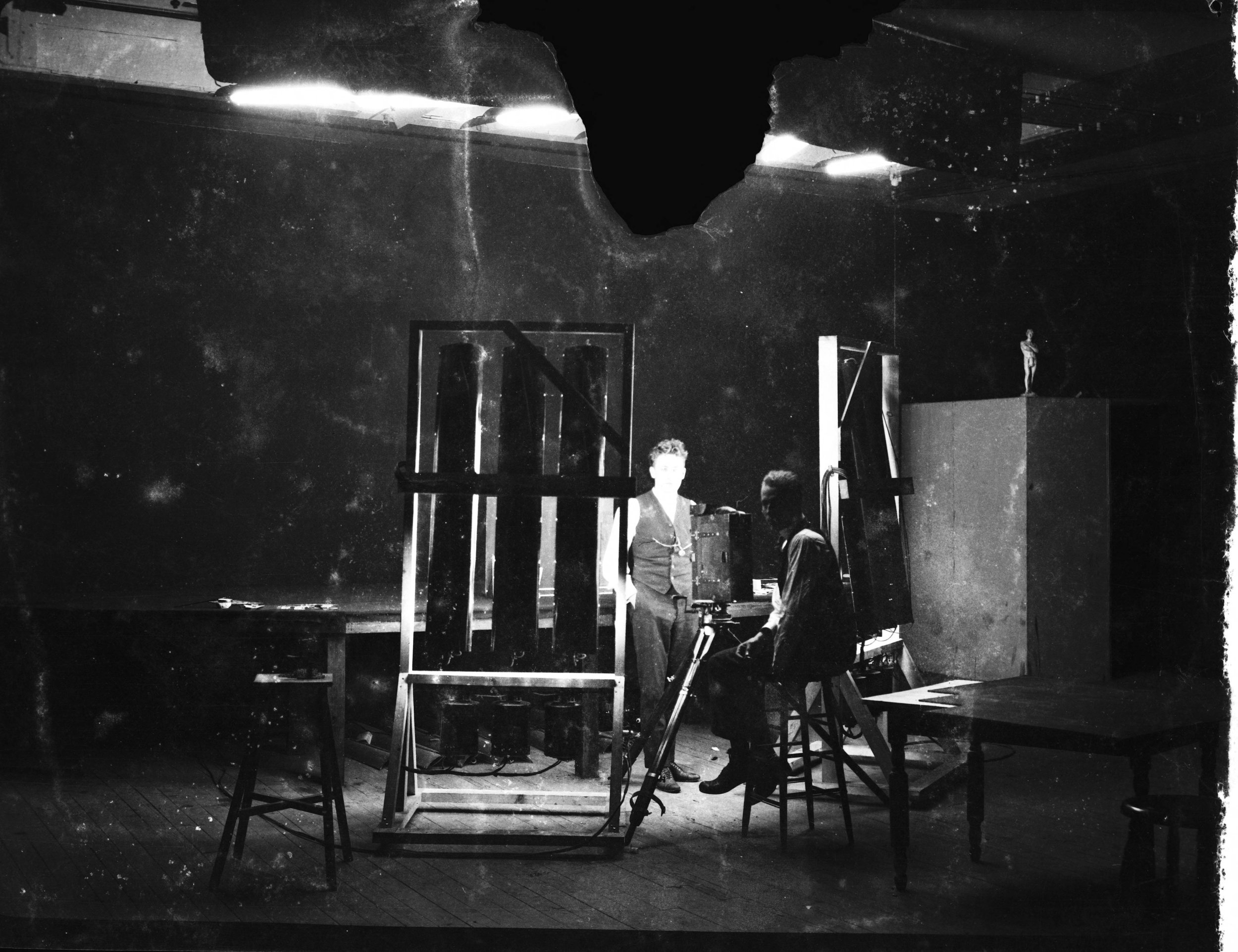Moy & Bastie 35mm Cinematographic Camera
Moy & Bastie 35mm Cinematographic Camera- serial no. 423
"Simple, efficient, reliable."
This 35mm motion picture camera, made in London by Moy and Bastie sometime after 1909, is the largest version available and is a typical British 'upright' style camera. It contains two vertically-mounted internal 400ft. film magazines or boxes and is Serial No. 423.
The Moy upright was the company's most famous camera, a well-made and practical design described in their catalogue as 'Simple, Efficient, Reliable.'
The camera's external case, interior central divider and two film housings are constructed from mahogany. The top of the case is fitted with a heavy duty leather carrying handle. On the right side, behind the door the brass gears and cast brass mechanism for the camera drive is chain driven and operated by a hand crank. The cast brass mounting mechanism also carries the makers name, patent number, date and serial number cast into the front plate. This side also houses the film footage dial. Focusing is achieved by viewing the image through the viewing tube under the sliding brass door on the rear of the camera.
Focus viewing window on rear.
The body is tropical or reinforced with brass hardware and hinges. All the corners are protected with brass reinforcements. The base of the case is provided with a screw fitting for the tripod.
The largest version had a price tag of £108, with an extra £5 for the Cooke lens.
Cook Optics, Leicester
The camera still has its original 2 Inch Cook Cinematograph Lens f3.5 Series II A, TT&H Ltd lens made in Leicester with serial number 79326.
The lens is notable as its been said that virtually all Hollywood films during the first half of the twentieth century were shot using Cooke lenses made in Leicester.
Film Transport
Moy & Bastie Chain Driven Movement
The camera utilize a unique film transport that has an eccentrically-grooved cylinder with rack-and-pinion gearing for back and forth movement of the claw used to achieve film pull-down Commonly referred to as the 'drunken screw' movement, It was also well known for its impressive chain driven movement and wonderfully finished brass gear wheels. It has an adjustable sector shutter with a spare 120 degree shutter stored inside the side door.
‘Drunken Screw’ movement
The two 32-tooth sprockets have wood guard rollers and on the side panel below the normal shaft for the hand crank, there is a single frame shaft as well.
32-tooth sprockets have wood guard rollers
Moy & Bastie Cinematographic Camera c.1908
Ernest F. Moy Ltd.
c.1885 Ernest Moy, at just 16 years old, was in charge of the lighting at London's Her Majesty's Theatre, one of the first electrically lighted theatres. He quickly advanced and became respected within the industry when he met another electrical engineer, Percy Henry Bastie.
In 1895, they joined forces and set up "Ernest F. Moy Ltd." to manufacture electrical equipment, including circuit-breakers and fuse boxes.
In the following year a customer and inventor, Robert Paul introduced them to cine cameras and suggested they try their hand at the emerging art. They were always fascinated with cameras and the application of electricity to them, so they began shooting films on the roof of their building with the help of another friend, William Friese-Greene.
Making their own films exposed the problems with the current cine cameras, so in 1897 and 1898 Ernest Moy submitted and was granted patents for improved film equipment. The partners then formed a new company, the "Cinematograph Company Ltd.", to handle this new business.
In 1900 they produced their first commercial film camera, but continued to put most of their efforts into designing and making electrical equipment. That changed in 1905 when Moy and Bastie sold a camera to Captain Scott for his Antarctic Expedition, and in 1907 they began to make special color cameras for Charles Urban's "Kinemacolor" film process.
Then, in 1909, the company began producing its most famous camera (Patent #4534), a well-made and practical design described in their catalogue as "Simple, efficient, reliable."
Moy at work in the Studio
Within a couple of years Moy cameras dominated British studio and news filming, and were in use throughout the world - it was even claimed that the first film shot in Hollywood was with a Moy & Bastie Cinematographic Camera. Because of its precision and practical design, this cine camera became one of the favorites among the emerging young cameramen in Hollywood.
British cinematographers during the First World War
On July 1, 1916, a British cameraman with a Moy and Bastie camera filmed the Battle of the Somme, and provided one of the most enduring images of the war.
The Moy & Bastie continued to to be a top choice in the market up until the end of World War I when the Bell and Howell and Pathe cameras took over as the cameras of choice for the industry.
Earnest Moy died in 1926 but Percy Henry Bastie kept the company moving forward using their electrical expertise to manufacture sound equipment in the new age of sound.
Ernest F. Moy Ltd.
Moy & Bastie camera on set.
Patent #4534
This Moy is one of my favorites in the collection. The film transport and movement are mesmerizing to watch, it is such a wonderfully engineered camera and this example, although it shows signs of a long working life, is still in beautiful condition after 113 years.



































